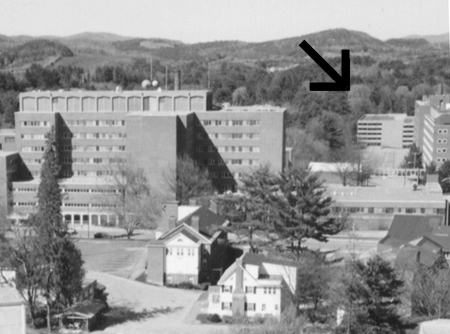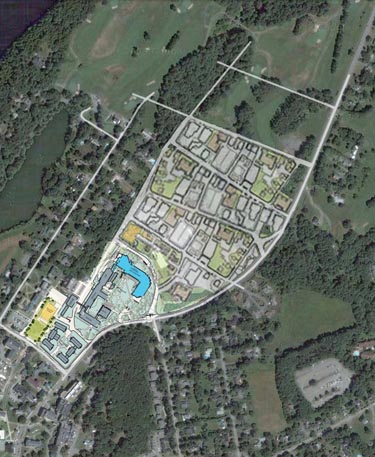- Hello, what’s this? The newest Google aerial shows hundreds of chairs and the big Commencement stage set up on the Green. It looks as if the photo was taken just before the Convocation on September 20. It is definitely recent: the Wilson Hall elm is missing, the Crouching Spider is visible, the new scoreboard is casting a shadow on the south end of Memorial Field, the Williamson is under way, Alpha Phi is in place, and the clearing has started for Kappa Delta at the end of Webster Avenue.
- The Planner’s Blog has a couple of photos of the start of the Triangle House renovation. The Trumbull-Nelson magazine has an article on the construction of Alpha Phi and a photo of the Kappa Delta foundation going in.
- Remember the big six-level parking garage in Dewey Field?

Built in 1972 to hold 490 cars, the garage is visible in this 1995 photo behind Remsen/Vail. The college demolished it in 1996. A Bing aerial shows the current state of the site at the northwest corner of the Dewey Field parking lot, and a Google Street View shows the site from the ground (pan around to see the Google engineers giving the camera trike a sendoff). - It turns out that ADD, Inc., the firm that designed the interior renovations of Home 36 and Home 50, did more than create a new headquarters there for Dana Library. It also created offices there for DCHCDS; and it designed interiors at 4 Currier Place.
- Some notes on education: A small article in Education Life in the Times covers an interesting project, the Minerva Schools. In this attempt to be a non-discount university at a discount price, the idea of renting space in a series of world cities is a neat one. (Also in the supplement is a wordy ad for MALS at Dartmouth (pdf) that seems undesigned — showing directness and honesty, one supposes.) A visit to a Virginia horse fair last weekend turned up booths representing the University of Findlay in Ohio and Centenary College in New Jersey. Interesting. Most of the other booths promoted saddles, animal feed, or pasture fencing.
Category Archives: CHCDS
A new coat of arms for Graduate Studies
Graduate Studies at Dartmouth (or “the Graduate Studies programs,” collectively lowercase) haven’t given the impression that they form a single school or college. Over the past several years, however, they have unified under a logo comprising the Old Pine, likely derived from the Bicentennial Flag, inside an oval. The oval logo is reproduced in a prior post and is vestigially visible on the current Grad Studies site.
Now Graduate Studies have a new coat of arms with a kinship to those of the other schools:

Graduate Studies coat of arms, from Graduate Studies
This shield has a woodcutty form similar to that of the recent Thayer School arms. The year “1885” (I think) in the base would be the year that Dartmouth granted its first Ph.D. degree; there is no singular institution here to claim a foundation date. (Some sources have Dartmouth giving a Ph.D. in 1877 to astronomer John Robie Eastman of the Chandler class of 1862.)
This iteration seems to place the numerals with a bit more success, from the DCHCDS site:

Graduate Studies coat of arms from DCHCDS application
The white pine is carried over from the earlier oval logo, and below it the lines of the New Hampshire hills create a depression rather than the rising hill (a peak of enlightenment to be ascended, etc.) found on Dartmouth’s seal. The lines also read as a pair of cradling hands.
It turns out this coat of arms is the product of a competition held last October. The competition brief required a representation of waves (have I misread those lines? The tree is growing out of the upper line) and referred contestants to the shields of Tuck, Thayer, and DMS — but not of Dartmouth itself. The brief also required entries to show the year 1960, which is when the current crop of grad programs began, and that must have been regarded as the “founding” year when the brief was published. There is a discussion in the comments about the advisability of dividing the year into two pairs of numbers, and some question about how and when during the competition the year 1885 was substituted for 1960.
All of the competition entries are available for viewing. Several alternate between the Grad Studies pine and the Bicentennial pine; several follow the Tuck School example fairly closely. One from SB Design deserves credit for depicting Wentworth Hall, the Grad Studies headquarters. Another sort of quarters the arms of the three Associated Schools, using the paths on the Green to divide the shield. The winning designer was Scott Gladd. (He has some alternative versions, including an intriguing one with Baker Library, in his portfolio.)
Now the logotypes of Dartmouth and its Associated Schools and related entities, as they are lined up at the bottom of the DCHCDS site, are one step closer to complete congruity. Only the hospital, the Institute for HP&CP, and the DCHCDS itself are without coats of arms.
Isn’t this interesting. Where the symbols of the appropriate programs are lined up for an online application form, both DIHPCP and DCHCDS (noted above as lacking logotypes) are represented by Dartmouth’s shield:

Row of logotypes from application.
—-
[Update 08.31.2013: Broken link to Gladd replaced.]
[Update 04.25.2011: Minor wording changes and date correction.]
[Update 01.22.2011: Second image replaced with better version; note about row of four logotypes added; competition information added.]
A new school in an old-school building
The Dartmouth reports that the new Center for Health Care Delivery Science will start teaching students this summer. According to the paper, the Center now occupies seven offices in 37 Dewey Field Road and soon will expand there. The 37 Building is one of the old Nursing School buildings north of the old hospital; the Wikimedia Commons shows it with what looks like a recent entrance addition.
The paper reports that the Center might get a new building in the future (this site has speculated about the school’s location and whether it will need a building).
Dartmouth’s new school
President Kim has announced the establishment of the Dartmouth Center for Health Care Delivery Science (press release, The Dartmouth, Valley News).
Following the habit of the Dartmouth Institute for Health Policy & Clinical Practice or “T.D.I.,” the new institution is being called “T.D.C.,” for “The Dartmouth Center.”
T.D.I. already awards master’s degrees, and T.D.C. is planning to do so. Even if the former institution were not expected to be absorbed by the latter, one might predict that a name change will be in order soon.
The word “Center” suggests a policy office or programming fund. (Cf. the Georgetown University Law Center, which is a law school rather than a legal aid clinic.) Dartmouth’s existing centers — Hopkins, Collis, Rockefeller, Dickey, Leslie and Visual Arts do not award degrees. The foundations that do award degrees are titled “College” or “School.” Only the word “Institute” is used in more than one way, by the degree-granting Dartmouth Institute, as noted above, and by the Ethics Institute, which is grouped formally with the centers. The new foundation seems to refrain from calling itself an “Institute” because that name is already taken.
President Kim’s foundation could be a Tucker-caliber move, an early identification of a need for a novel form of graduate-level education. The new foundation will be prominent and could end up with a public character more like that of the Tuck School than of T.D.I. Therefore one might predict that the name eventually will be changed (a) to refer to the donor, who is anonymous at the moment; (b) to omit the word “Dartmouth” or move it to the end (“the ____ Center at Dartmouth College”); and (c) to reflect the institution’s ambitions and authority by becoming an actual “School,” or at least an “Institute.”
At the very least this new foundation will occasion a change in Dartmouth’s academic heraldry:

Detail from T.D.C. website.
The professional schools have been adopting coats of arms in parallel to that of Dartmouth over the past 60 years, most recently at Thayer School. Neither T.D.I. nor the Graduate Studies Program, which is not yet a school, has joined the pattern. But at least G.S.P. has its Lone Pine; T.D.I., with only a logotype, would seem to be the only degree-granting body left out of the group. The above grouping includes T.D.I. and the medical center because it is meant to identify the partners of T.D.C.
[It seems to appropriate to mention the example of the “Harvard Chief” and its role in unifying Harvard’s various frank and memorable coats of arms, such as those of the Schools of Engineering and Law.]
—–
[Update 06.09.2013: Broken link to Harvard Engineering arms replaced.]
The Dartmouth Institute of Health Care Delivery Science
A Valley News article reports President Kim’s suggestion that Dartmouth host a national institute of the science of the delivery of health care. One imagines that it would accompany or expand upon the existing Dartmouth Institute for Health Policy and Clinical Practice. That institute is scheduled to occupy the postponed future Koop Medical Science Complex at the south end of the Dartmouth-Hitchcock Medical Center (map).
If not located at the hospital, however, such an institute would make an excellent candidate for placement north of the medical school, even on the golf course. It would not require parking for patients; it would benefit from its proximity to downtown — walkable if not convenient enough for a student function — and yet it would be indisputably part of the college.
To allay the concerns expressed here last year, this building and any other buildings on the site should be made to follow the form of the town, not the campus. A grid of streets with sidewalks and buildings, rather than a network of curving driveways with lawns, would promote density while acknowledging that the college does not expect students to walk this far from the Green on a regular basis. The buildings would harmonize with the campus without pretending to be a part of it — much more South Block than McLaughlin Cluster.
The Institute for Security, Technology, and Society could move to the site, along with other administrative offices now at remote locations, such as the offices in the bank building on Main Street and the Development Office, which is in Centerra.
The perfect completion of such a plan would involve the Hanover Country Club House. The club has wanted a larger and more convenient clubhouse for several years. A new east-west connector street at the north end of this expansion project, crossing the south end of the golf course between Lyme Road to Rope Ferry Road, could provide an excellent site for such a building. The clubhouse would occupy the north side of this street, looking up the stretch of greensward; the south side of the street would be a densely-built wall representing the end of the urban development of Hanover. Compare the fascinating conditions of the Royal and Ancient Golf Club of St. Andrews.
In Hanover, the clubhouse would stand on the north side of the northern cross-street, whichever was built:

Example of town-form development
—–
[Update 05.03.2014: Broken link to DIHP&CP facts and figures replaced.]
[Update 09.25.2010: With all this talk of buildings, it never occurred to me that the Dartmouth Center for Health Care Delivery Science would be mostly on-line.]
[Update 02.06.2010: Map added.]